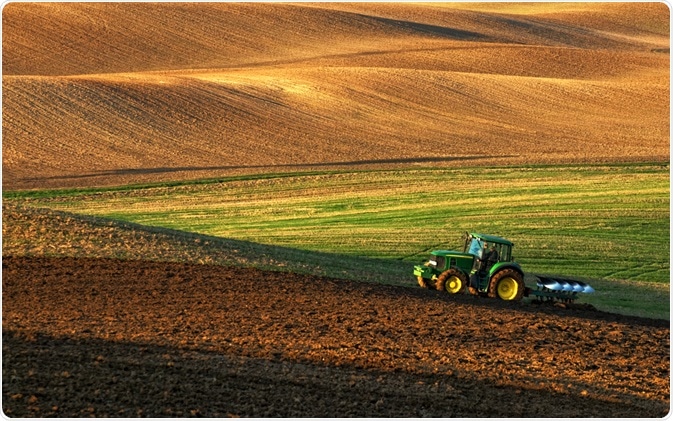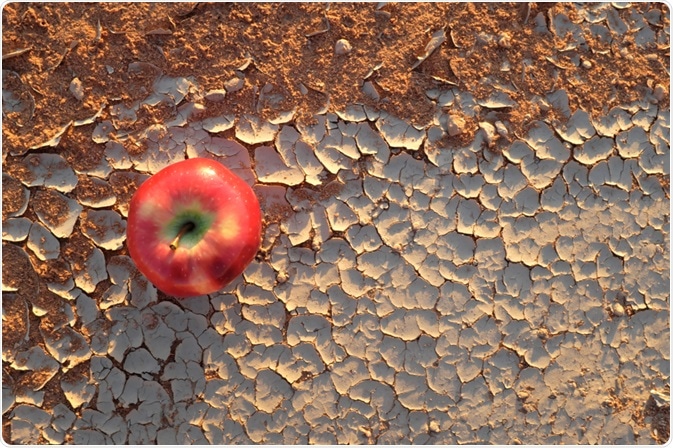Although COVID-19 is a health crisis, it has further complicated many of the challenges that currently affect the global agricultural industry, which includes climate change, food security, and the rate of food exports from other countries.

Agriculture. Image Credit: Svend77/Shutterstock.com
Introduction
In December 2019, the novel severe acute respiratory syndrome coronavirus 2 (SARS-CoV-2) that is responsible for the coronavirus disease 2019 (COVID-19) was first identified. As the virus continued to spread to other countries around the world, the World Health Organization (WHO) on March 11, 2020, officially declared the COVID-19 outbreak as a pandemic. To protect public health and potentially prevent the further spread of this disease, governments around the world initiated several different measures ranging from media announcements to complete lockdowns.
Many of these measures led to profound changes in the buying and consumption habits of consumers around the world, which subsequently affected almost every sector of the economy, particularly that of the agricultural industry. In addition to the damage that the COVID-19 crisis has generated on its own, the pandemic has also further exacerbated many of the challenges that were already causing a strain on the current agriculture and food systems of the world.
COVID-19 and climate change
Although South Asia is home to only 5% of the world’s agricultural land, the farmers of these countries feed over 20% of the global population. To meet the global demand of a growing population, many farmers in this region have adopted certain agricultural practices that can increase their rate of food production, but also have serious negative impacts on the environment and public health.
The excessive use of agrochemicals, combined with the unstable use of both water and energy supplies over several decades, continue to contribute to the release of a large amount of greenhouse gas emissions (GHGs) into the environment, pollution of both water and air supplies, water and energy scarcity, a loss of biodiversity and, inevitably, risks to human health.
Like climate change, COVID-19 is also a global crisis that is interconnected both directly and indirectly to the agricultural industry. As a result of the pandemic, farmers around the world who are already suffering as a result of unpredictable climate conditions are also challenged with uncertainties surrounding their ability to produce, market, and transport their food products without delays that have been caused by the current pandemic.
Reduced agricultural input
To mitigate the spread of the coronavirus, South Asian countries have taken stringent policy measures in the form of barring only a few essential services, banning travel, restricting the movement of goods and services, and closing cross-border movement. As much of the labor force of the agricultural industry in South Asia is comprised of migrant farmworkers, these lockdown orders have prohibited them from traveling to work.
Additionally, for the labor workers who have been able to continue their work, they are required to abide by strict physical distancing policies, which has also slowed down production rates. While these measures are extremely important for saving lives, they have inevitably affected agricultural activities and supply changes including the marketing, transportation, distribution, and consumption of agricultural goods.
How COVID-19 has affected food security
South Asia is considered to be one of the poorest regions of the world, with over 30% of the world’s poor living in South Asian countries and 70% of the people in this region living in rural areas. A majority of South Asian citizens primarily depend on agricultural work to not only provide nourishment and food for their survival but also as their source of income.
Despite the strong presence of agriculture in this region, it is estimated that before the COVID-19 pandemic, approximately 650 million people in South Asia were moderately or severely food insecure. As a result of this widespread food insecurity, approximately 36% of children within the South Asia region were stunted and 16% were acutely malnourished.
The aforementioned food security challenges of South Asian countries have continued to worsen as a result of rising food prices and the widespread loss of jobs and livelihoods. Poorer households that previously struggled to meet food and nutritional requirements have been forced to further reduce their expenditure on food items.
A healthy diet and good nutritional status are crucial in supporting the immune system, which can subsequently determine an individual’s susceptibility to the severe effects of illnesses like COVID-19. Not only has the global pandemic further contributed to the severe food scarcity in developing nations, but it has also further complicated the ability of these individuals to protect themselves against deadly illnesses like COVID-19.

Image Credit: sulit.photos/Shutterstock.com
Cross-border trade challenges
As previously mentioned, when the global pandemic was officially announced, many countries around the world quickly decided to shut down their borders to prevent the entry or further spread of the virus in their nations.
Since there was no end in sight at the beginning of this pandemic, several grain-exporting countries initially restricted their exports out of fear that limited agricultural output would not be able to sustain the needs of their populations. These restrictions not only disrupted the international trade of these products but also altered the confidence of the global food market in their ability to ensure food security for their people.
Aside from the effects that travel bans had on international trade, transportation restrictions also caused severe losses for farmers. In India, for example, while the distribution of rice was not significantly affected, the inability to transport fresh fruits, vegetables, and milk caused a high post-harvest loss and reduced income to farmers who produce these products. These effects were not only a direct result of transportation restrictions but also due to the lack of measures taken by governments to ensure the safety of labor workers and food transporters. Taken together, the global decline in food trade has limited the availability of food to reach remote areas and has caused prices to skyrocket in many areas of the world.
Sources
- Lioutas, E. D., & Charatsari, C. (2021). Enhancing the ability of agriculture to cope with major crises or disasters: What the experience of COVID-19 teaches us. Agricultural Systems 187. doi:10.1016/j.agsy.2020.103023.
- Rasul, G. (2021). Twin Challenges of COVID-19 Pandemic and Climate Change for Agriculture and Food Security in South Asia. Environmental Challenges. doi:10.1016/j.envc.2021.100027.
- Ben-xi, L., & Zhang, Y. Y. (2020). Impact of the COVID-19 pandemic on agricultural exports. Journal of Integrative Agriculture 19(12); 2937-2945. doi:10.1016/S2095-3119(20)63430-X.
- Adhikari, J., Timsina, J., Khadka, S. R., et al. (2021). COVID-19 impacts on agriculture and food systems in Nepal: Implications for SDGs. Agricultural Systems 186. doi:10.1016/j.agsy.2020.102990.
Last Updated: Feb 25, 2021